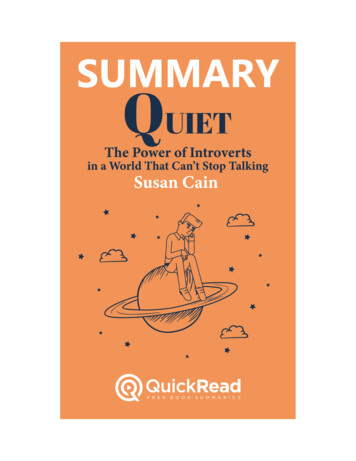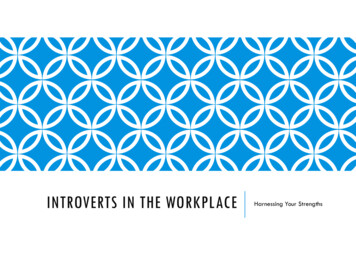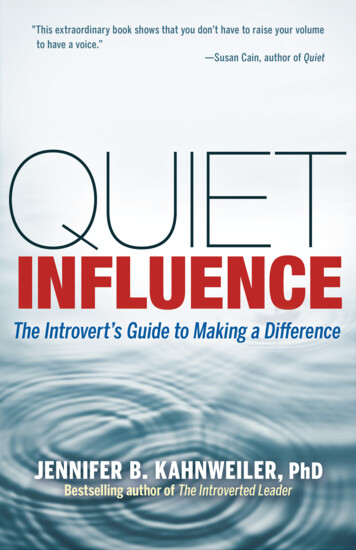
Transcription
Summary of Quiet: The Powerof Introverts in a World ThatCan’t Stop Talking by SusanCainWritten by Lea SchulleryA revolutionary book detailing how society vastlyunderestimates introverts and teaches us whatintroverts and extroverts can learn from oneanother.
IntroductionIn today’s world, we have two types of people. Introverts and extroverts. Onthe surface, society views extroversion as the ideal, they are social,outgoing, and thrive as leaders and in positions of power. Introverts, on theother hand, are seen as socially awkward, quiet, and shy away fromleadership and power. But why does society value extroverts overintroverts? For centuries, business leaders of the western world have beenseen as domineering, bold, and making rash decisions. However, as SusanCain presents, extroverted leaders have their downfalls as well. In today’sworld, it’s important to recognize the differences in the two temperaments,and it’s even more important to understand one another.Find out the history of the rise of the extroverted leader, see how othercultures have drastically different personality ideals, and finally, learn howboth introverts and extroverts can come together to recognize their truepotential.
The Rise and Myth of the Charismatic LeaderWhen you meet a new person, how do you determine their personality?Depending on the encounter, you’re likely to figure out if a person is eitherintroverted or extroverted. While extroverted people tend to be outgoing,gregarious, and enjoy the attention, introverts are more reserved, calm, andquiet. While you may not be able to determine this personality trait afterjust one meeting, it certainly becomes a critical factor in describing aperson’s disposition and character. And in today’s society, one of thesetraits is certainly more valued than the other. But was society always thisway? When did Western society begin to associate extroversion withsuccess and likability, and introversion with skepticism and unfriendliness?In the early 1900s, Americans valued the serious, honorable, anddisciplined character. Historian Warren Susman defines this era as theCulture of Character but this culture quickly began to shift in the earlytwentieth century when Americans began a Culture of Personality. This newculture focused on people valuing how they were perceived by others andemphasized likability and charisma as a critical quality of successful people.By the 1920s, self-help books began flying off the shelves influencing mento sell themselves by being outgoing, likable, and dominant whereas womenwere taught to project charisma and personal magnetism to attract men.These ideas were then pushed on the masses through marketing strategiesthat capitalized on people’s insecurities and anxieties. For example, theshaving cream campaign from the 1930s that warned consumers“CRITICAL EYES ARE SIZING YOU UP RIGHT NOW.”Even worse, experts began to target shy children and warned parents aboutthe dangers of not addressing or “fixing” the problem. Parents were advisedto start sending their children to school at younger ages and encouraginggregarious, social behaviors. Additionally, colleges began seeking “wellrounded” candidates who were both academically smart and socially adept.Wishing to prepare students for the business world which praisedcharismatic dominant personalities, institutions became skeptical of the
“brilliant loner types” who were increasingly seen as “unprepared” for thereal world.Institutions like Harvard Business School (HBS) are largely driven by theidea that leadership and dominance are strong correlations. For instance,students of HBS are expected to engage with their peers at all timeswhether they are participating in study groups, eating lunch, or evenattending parties and hanging at the bar. Students that don’t participate insuch activities are met with skepticism and suspicion; however, thisExtrovert Idea has largely been disproven through successful introvertedindividuals including Bill Gates, Charles Schwab, and Brenda Barnes.Additionally, Craig Newmark, the founder of the website Craigslist, is also aself-proclaimed introvert who is far more interested in activities like chessversus making conversation.At the end of the day, charismatic leadership is simply a myth. For the lastcentury, society has largely believed that to be successful, you have to bedomineering, gregarious, and charismatic; however, in the past fewdecades, we have seen successful men and women who exhibit introvertedbehaviors disprove this previous Extrovert Ideal.
The Power of Soft PowerWhile the western world has developed its own Extrovert Ideal, each part ofthe world has their own version of what the ideal personality looks like. Theeastern side of the world has a strikingly different attitude towards whatthey consider the cultural norm. In fact, while westerners valuedomineering and bold personalities, Asian and Asian-Americans have whatCain considers “soft power” to define their ideal personality.Take the public school system in Cupertino, California for instance.Ironically, many white families have been moving away from the area dueto the increase in competitive academics and the fear that many of theirchildren cannot compete with the high number of Asian and AsianAmerican students. In fact, the students at Cupertino are so focused onacademics that the typical social hierarchy of the school looks far differentfrom many other schools throughout the USA. While many schools have amore socially driven environment, Cupertino’s environment certainlyrevolves around academics and studies. This is partly due to the Asianinfluence whose culture values quiet study and respect of authority.Researcher Robert McCrae documented the cultural differences betweenwestern and eastern society, noting that Asian cultures valued introvertedstyles of communication and leadership. The biggest barrier comes fromAsian borns who try to succeed in the business world of Americancompanies. Throughout several interviews with Asian-born and AsianAmerican business professionals, Cain states that many are aware of thestriking cultural differences. But many agreed that one style of leadershipwas neither worse nor better than the other.Instead, Preston Ni, a communications professor, argues that many peoplecan adapt to the style that the western countries have adopted, but there arecertainly several other styles of leadership that are just as successful. Stylessuch as soft power offer a sense of kindness, respect, and quiet persistencethat is not typically seen throughout their western counterparts. Some of
the greatest leaders in the world, like Mother Theresa and Gandhi, are bothrepresentatives of people who have successfully used soft power to leadothers and change the world.
The Power of Working AloneIf society largely believes that extroversion correlates with success, thenhow is it that introverts like Bill Gates who founded Microsoft and SteveWozniak who co-founded Apple, Inc. were able to create some of the mostsuccessful businesses seen today? Large corporations, institutions, andschools are emphasizing the concept of “New Groupthink,” whichhighlights the importance of group dynamics to improve creativity andinnovation; however, author Susan Cain believes the power of workingalone is critical for brainstorming ideas and increasing productivity.For example, in Steve Wozniak’s memoir, Wozniak insists that hismoments of working alone were the catalysts that contributed to his mostimportant creative breakthroughs. Introverted individuals are likely to bemore creative than those who are extroverted, but the key to unlocking thatsuccessful innovation is through periods of solitude where an introvert canconcentrate more effectively. For instance, when trying to hone your skillsin an area of interest, how do you master that skill? Through practice,right? You incorporate deliberate practice where you spend timeconcentrating and fine-tuning your skills individually. With fewerdistractions, you are far more likely to improve in solitude versus being putin a group.Additionally, Cain proves that two is no better than one. As a society, we’velargely emphasized that two heads are better than one, that collaboration iskey in fostering creativity and innovation. However, group scenarios canbecome more harmful than successful. For instance, when placed in agroup, introverts are more likely to become insecure in their ideas and fearjudgment for speaking out. In fact, many group scenarios affect theperceptions of other group members as they adopt the dominant member’sideas, completely negating the purpose of group collaboration.While face-to-face collaborations certainly have their time and place, Cainsuggests that we become our best when we combine the benefits of
collaboration and independent work rather than immediately defaulting toGroupthink tactics. Giving people the flexibility to opt-out of social orprivate work allows them to maximize their productivity and recognizewhich scenarios they are likely to thrive in. Many successful corporationshave adopted this kind of work environment like Pixar Animation Studiosand Microsoft Headquarters.
The Orchid HypothesisWhich affects our personalities more? Nature or Nurture? Some believethat our genetics influence our personalities more while others believe ourenvironment is largely more influential. You see, we all thrive in differentenvironments. Some of us thrive on the energy of a loud concertsurrounded by thousands of people with ear-shattering music, while othersgain energy when in the quietness of their own house with their nose in abook. These environments are drastically different, but some people mightfind a loud concert synonymous with torture whereas some find that thequietness of their own home drives them crazy. Well, our brains might belargely responsible for this stark dichotomy.Developmental psychologist, Jerome Kagan, sought to find out why peoplehave such striking differences. To do this, he exposed 500 infants to certainstimuli and analyzed their reactions. These stimuli included smellingalcohol-soaked cotton swabs while simultaneously listening to the sound ofpopping balloons. The results showed two distinct behaviors: 20 percent ofinfants reacted to the stimulus by kicking and screaming and experienced arise in blood pressure. These infants fell into the highly-reactive categorywhile 40 percent of infants fell into a low-reactive category, where theyhardly reacted to the stimulus at all and remained calm and coolthroughout the experiment.Kagan predicted that the highly reactive infants would grow up to be moreintroverted while those who had a calm demeanor would be moreextroverted. His theory then argued that the cause of such reactions waslargely controlled by the part of the brain known as the amygdala. Theamygdala is the first place to receive stimulus from our sensory organs anddetermines our reactions to that stimulus. The infants who fell into thehighly-reactive category have a sensitive amygdala, which leads to aparticularly strong reaction from external stimuli. This is why certainpeople prefer low-stimulation surroundings such as the quiet of their homeor the library. So while nature certainly plays a role in our personality, our
environment can become critical in developing the personalities in childrenas well.For instance, extroverted children will seek out extra stimuli so they aremore apt to take risks. Unfortunately, children in poorer neighborhoodswith fewer opportunities are more likely to engage in delinquent activities.But despite this increase in delinquency, extroverted children can stillthrive in all kinds of environments. However, the environment ofintroverted children can profoundly affect them due to their increasedsensitivity. This leads to the “orchid hypothesis” in which introvertedchildren will flourish in the right environment, but in the wrongenvironment, they will shut down or close up completely.Researcher Stephen Suomi suggests that those with higher sensitivitiesspend more time observing and reflecting on social behaviors anddynamics. This is why in a nurturing environment, introverted childrenhave the opportunity to practice their social skills and become selfconfident, well-rounded adults; however, in an overstimulated or pressuredenvironment, those same children are likely to develop depression orrespiratory disorders. So when it comes to nature versus nurture, they eachplay an equally significant role in developing the personalities of ourchildren.
Introverted Versus Extroverted LeadersSo which type of personality trait is best for fostering a productive workenvironment? Is one better than the other? Many people might think thatextroverted personalities are more likely to “get things done” due to theirdomineering disposition while introverted personalities are seen as meekand lack the power and authority to motivate their employees. Well, in anattempt to prove these theories, a group of scientists asked teams to do asimple task: fold a T-shirt. Of course, each team was assigned either anintroverted or extroverted leader to provide guidance.While extroverted team leaders were certainly successful in providing clearinstruction and getting their team members to adhere to the rules, theywere less likely to respond to individuals’ suggestions. For instance, someteam members tried to make suggestions on how to make the T-shirtfolding process quicker and more efficient, but team leaders were morefocused on following the rules. On the other hand, introverted team leadersshowed the exact opposite. While their calm demeanor hindered theirability to encourage their team’s productivity, they were more receptive tosuggestions which led to utilizing their team member’s ideas.So what can be learned from this experiment? Well, extroverted leaders arebest when the end goal is to complete simple tasks as efficiently as possible;however, introverted leaders are ideal for places where team members needto get involved and put in their own input.However, the differences don’t stop there. In fact, the difference betweenextroverted and introverted leaders can be directly linked to many of thefinancial troubles that banks faced during the 2008 financial crisis. Becauseextroverts are more likely to take risks and make quick decisions, thesetypes of leaders were valued in the financial world. In fact, cautiousinvestors were actively passed over for promotions because they were lesslikely to make such high-risk decisions. However, these corporations would
soon feel the effects of such risky investments once the financial bubbleburst in 2008.While many companies paid for their high-risk investments, companieswith introverted leaders found themselves thriving during the 2008 crash.For instance, Seth Klarman, the president of the hedge fund, BaupostGroup, took a more risk-aware approach to investments and ended updoubling the assets of Baupost. Through reflection and thoroughconsideration, companies like Baupost were able to avoid a financial crash,therefore, it literally paid to be an introvert during the Great Recession.
When to Be More ExtrovertedWhile introverted investors got paid during the financial crisis, there arecertainly going to be times where an introvert will need to step out of theircomfort zone. Retired psychology professor, Brian Little, contributed to the“Free Trait Theory” which suggests that although our personality traits arerelatively a combination of biological and cultural forces, we can change ourpersonality to be more successful in certain environments. For instance,when a goal becomes highly achievable to us, such as achieving career goalsor finding success in relationships, then even our most stable personalitytraits become changed by adopting these free traits.But how can one do this? How can an introverted team member step out oftheir shell and make a strong presentation? How can an introvertedprofessor instill the love of learning in their students? While adopting thesefree traits can certainly work, Cain also suggests that some people adopt a“self-monitoring” behavior in which they mimic the behavior of otherpersonalities when necessary.For instance, a college professor can switch from introvert mode toextrovert mode by adopting behaviors of other extroverted professors. Soduring her lecture, she might project her voice louder, speak more clearly,take longer strides as she walks in the classroom, and then maintain arelaxed posture throughout the duration of her lecture. In the end, theprofessor accomplishes her goal. She can teach her students the materialthey need as well as foster their love of the subject. At the end of the daythough, the professor needs to fill up her energy levels again as actingextroverted is both exhausting and tiresome. So, she will probably retreat toher office or into the corner of the library away from social interaction to fillup her depleted energy.
Cooperation of TemperamentsBy now you probably are relating to one personality or another, you realizethat you are either more extroverted or introverted. Do extroverted peoplestruggle to understand the other, and vice versa? Many times they do. Forinstance, when put in stressful situations, extroverts will tend to becomemore hostile or aggressive while introverts shrink back and retreat to safetyelsewhere. They thrive on different energies and this can result in a lack ofcommunication or an easy misunderstanding. However, while introvertsand extroverts are vastly different, there are many ways in which introvertsand extroverts have come together and brought their respective strengths tothe forefront for the betterment of society.Take, for example, Eleanor and Franklin D. Roosevelt. Eleanor was wellknown for her serious, shy personality while Franklin was an outgoing, boldsocialite who thrived at parties and social events. Eleanor, however, thrivedon serious conversations and would leave those parties and social events asearly as possible. However, the two achieved great things together. SinceEleanor was more understanding and sensitive, like an introvert, she wasable to shed light on issues like poverty and oppression of minorities thather boisterous counterpart may not have been aware of.For instance, in 1939 when Eleanor found out the black singer, MarionAnderson, was not allowed to perform in Constitution Hall, sheimmediately took action. She was able to utilize Franklin’s political cloutwith her own social conscience and ensure that Marion Anderson wouldperform in front of Lincoln Memorial on Easter Sunday. The twotemperaments can accomplish great things, but it’s important to know howto communicate with one another.The case of Greg and Emily shows how communication is key when twopeople share opposite temperaments. Since Greg is incredibly extroverted,he enjoys throwing dinner parties every Friday night while his partner,Emily, fears the dreadful Friday night get-together. Their differences in
personality caused many fights and conflicts since the two couldn’tunderstand one another. However, after direct confrontation and healthycommunication, the two were able to come up with a compromise to keepboth people happy. The two agreed to do bi-weekly parties, and Greg evenagreed to change the dynamic of the dinner. What was once a sit-downdinner would now become buffet-style, allowing Emily to have moreintimate conversations with smaller groups of people.Understanding how people of the opposite disposition approach socialinteractions is key to getting along with one another. By addressing theother’s needs for relaxation or social interactions can facilitate smootherrelationships in all areas, be it romantic, professional, or familial.
Final SummaryThere are many differences between extroverted and introverted people.While extroverts enjoy loud noise and need stimuli, introverts preferquietness that allows them to be alone and with their thoughts. Additionally,introverts tend to be far more sensitive to their environment and retreatwhen exposed to stressful situations. For this reason, extroverts have beenvalued by western society for the past century. Believing that extroverts canget things done more efficiently, these personality types have thrived inwestern society, especially in the business world. But, as Cain proves,neither is better nor worse than the other. Instead, each has its ownstrengths that can be utilized both professionally and personally. Cainpoints out the many business leaders of America who were introverts andsuggests that companies stop catering their company culture to extroverts.With Groupthink strategies and an emphasis on collaboration, introverts arefailing to live up to their fullest potential. Instead, western culture thrivesmost when the strengths of each temperament are addressed. So, throughrecognition, communication, and cooperation, both introverts and extrovertscan thrive and survive in the western world.
Summary of Quiet: The Power of Introverts in a World That Can’t Stop Talking by Susan Cain Written by Lea Schullery A revolutionary book detailing how society vastly underestimates introverts and teaches us w










